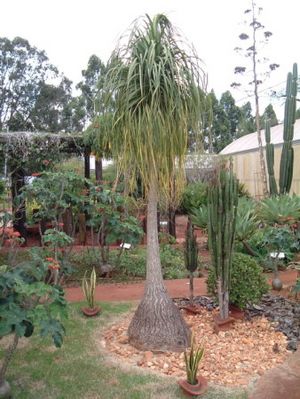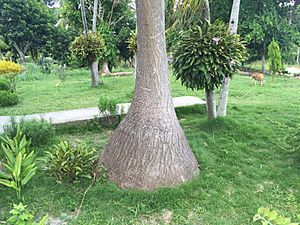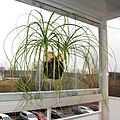Ponytail palm facts for kids
Quick facts for kids Ponytail palm |
|
|---|---|
 |
|
| Conservation status | |
| Scientific classification | |
| Synonyms | |
|
The ponytail palm, also known as elephant's foot, is a unique plant. Its scientific name is Beaucarnea recurvata. It belongs to the Asparagaceae plant family. This plant originally grew in many parts of eastern Mexico. Now, it is mostly found in the state of Veracruz. Even though it's called a "palm," it's not a true palm tree. People around the world love to grow it as a beautiful ornamental plant in their homes and gardens. Some ponytail palms in Mexico are over 350 years old!
Contents
What the Ponytail Palm Looks Like

The ponytail palm is an evergreen plant. This means it stays green all year long. It can grow up to 15 feet 6 inches (4.7 meters) tall. The plant has a very wide base called a caudex. This caudex stores water, helping the plant survive dry times.
The plant has a single stem that looks like a palm tree trunk. At the top, it has many long, thin leaves. These leaves are strap-shaped and curve downwards. Sometimes, they look like a ponytail or a lock of hair. When the plant is over 10 years old, it can grow small white flowers. These flowers appear in clusters called panicles.
The trunk starts wide at the bottom and gets thinner as it goes up. It usually does not have many branches. When the plant is young, its base is almost round. As it gets older, this base can grow up to 4 to 6 meters long. It can also be as wide as 50 centimeters or more. The outer layer of the trunk, called the bark, is smooth. The leaves are green and look like lines. They are thin and can be flat or slightly ridged. Each leaf can be 90 to 180 inches (2.3 to 4.6 meters) long and 15 to 20 millimeters wide.
Where the Ponytail Palm Lives
The ponytail palm naturally grows in dry forests. These forests are called low deciduous forests. The average temperature in these areas is about 20°C (68°F). They get about 800 millimeters (31.5 inches) of rain each year. There is also a long dry season that lasts 7 to 8 months.
These forests are found at different heights, from sea level up to 1700 meters (5,577 feet) high. The plants often grow on rocky ground that does not have many nutrients. They can also be found on cliffs and steep mountains. The ponytail palm can handle temperatures as low as 10°C (50°F). It grows well in full sunlight or in a little bit of shade. These plants grow very slowly. They are also very good at surviving droughts, which means they don't need much water. You can grow them in pots or as trees in your garden.
How to Grow a Ponytail Palm
The ponytail palm has won an important award called the Royal Horticultural Society's Award of Garden Merit. This shows it is a great plant for gardens. Many people grow Beaucarnea recurvata as a houseplant. It can also be grown outdoors in places with mild weather.
This plant grows slowly and does not need much water. It can survive cold temperatures down to -5°C (23°F). It likes full sun or light shade. When you water it, make sure the soil drains well. Be careful not to give it too much water. Too much water can attract tiny pests like mealybugs and cochineal insects.
If you live somewhere with very cold winters, you should keep your ponytail palm indoors. It cannot handle very cold temperatures. To keep its natural shape, you should not cut the ends of its leaves. When you move it to a new pot, make sure all its roots stay in place.
Protecting the Ponytail Palm
Many plants in the Beaucarnea group are in danger. This is because people are changing and destroying their natural homes. Their habitats are being broken up into smaller pieces. Also, people collect the seeds, young plants, and even adult plants to sell them. This has made the plant populations smaller. It also makes it harder for them to reproduce. This means fewer new plants are being made.
When too many plants are taken, it can reduce how many plants are left. It also harms the plant's genetic diversity. This makes the species weaker and more likely to disappear. In Mexico, Beaucarnea recurvata is listed as a threatened species. This is according to Official Mexican Standard 059-ECOL-2010 by SEMARNAT.
This plant is also listed in Appendix II of the Convention on International Trade in Endangered Species (CITES). This means that trading the plant or its parts across countries is controlled. You need special permits to do so. This helps protect the species from being over-collected.
Gallery
-
A ponytail palm in Homestead, Florida.
-
A ponytail palm grown as a kokedama (a plant in a moss ball) on a balcony in Prague, Czech Republic.
See also
 In Spanish: Pata de elefante para niños
In Spanish: Pata de elefante para niños











